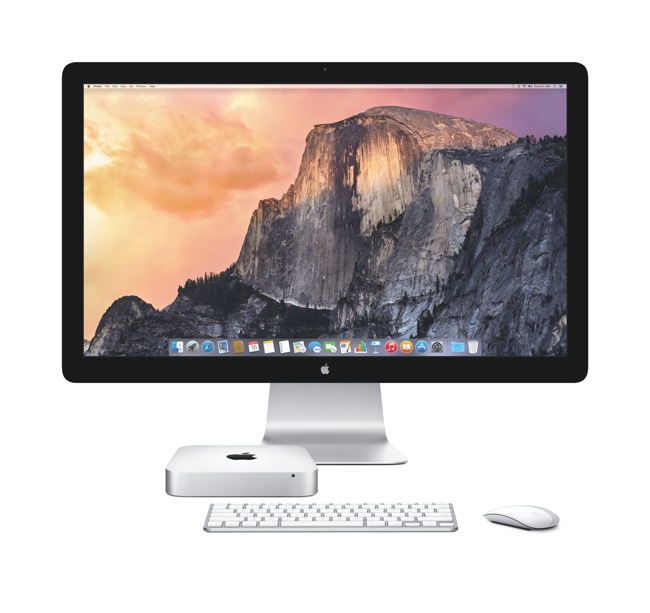
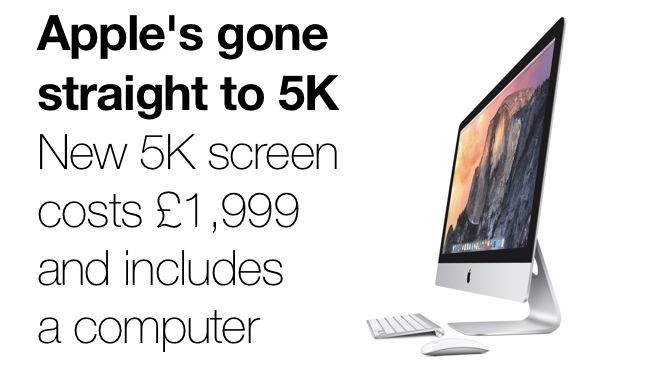 Retina iMac
Retina iMac
For ages, we've been predicting a 4K Mac, but we were wrong! It's 5K! For pretty much what you'd have expected a 5K computer monitor to cost, Apple's thrown in a very capable computer. It's reduced the price of Mac Minis as well. It's never been cheaper to do serious stuff on a Mac. Oh, there are some new iPads as well. K. Stewart, our own Apple Expert, gives the full details
That spectacular iMac screen apart, pricing was the most surprising element in Apple’s second and final 2014 event.
After the sprawling Flint Centre auditorium Apple rented for $1m to host last month’s Apple Watch preview, this was a decidedly more homely event back at Apple’s Cupertino campus: whenever Tim Cook moved slightly to the left of the cramped stage a green exit sign could be spotted. Nevertheless, while most of what was revealed had been leaked beforehand, Apple still had some surprises to reveal.
iMac goes 5K
While Mac Pro owners might feel a bit hard done by, the advent of Apple’s first Retina desktop screen will ship as an iMac rather than a standalone monitor. Available to buy now at a starting price of £1999, the flagship 27-inch iMac with Retina Display was undoubtedly the technological star of this event and, by that, we really mean its screen. The iMac’s slimline all-in-one form factor is unchanged, while this year’s Haswell CPUs and AMD Radeon are a solid improvement over last year’s internals, but all the focus is on that spectacular screen.
The resolution is 5120x2880 with a PPI of 217 (compared to 220 for Retina MacBooks) and Phil Schiller called it simply the world’s highest resolution screen. 14.7 million pixels is roughly equivalent to 7 x a standard 1080 HDTV screen, 4x the previous iMac screen and 67% more pixels than even a 4K screen. A remarkable engineering achievement in its own right, even more so when shoe-horned into the iMac’s slimline chassis (which tapers to 5mm at screen edges) as well as conforming to Apple’s environmental marketing by using almost a third less power than the 2013 model.
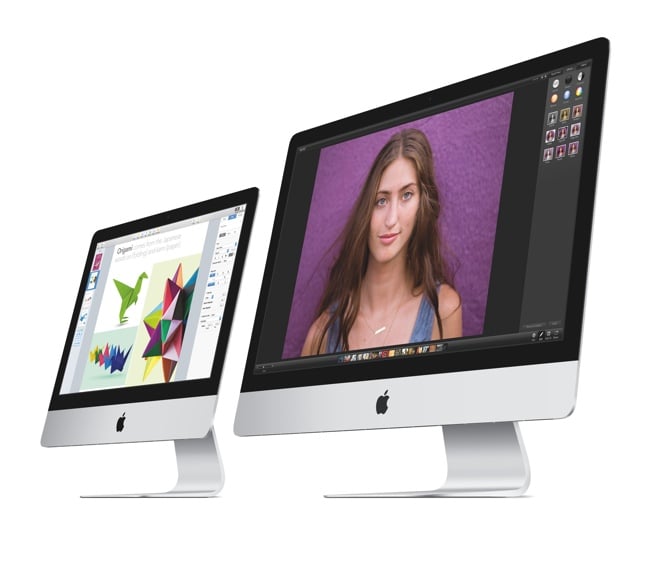
To drive the display, Apple had to develop its own timing controller chip (TCON) with four times the bandwidth (up to 40Gbps) of the previous chip. Other key technologies include a precision Oxide TFT (for consistent brightness), LEDs for energy efficiency within the slimline case and organic passivation (introduced with the first Retina iPad) reduces cross talk interference between densely packed pixels.
Apple has consistently scored highly in the mobile space with the colour accuracy of its screens, so we’ll be very interested to see how the Retina iMac performs when subject to lab tests in comparison to high-end reference monitors. Is there a price to pay for all that resolution? First impressions are spectacular and the usability benefits for editing 4K footage are clear, but will it really live up to first impressions?
The entry-level Retina iMac ships with a 3.5GHz quad-core Intel Core i5 processor, 8GB RAM, a 1TB Fusion Drive (hybrid flash/hard drive) and AMD Radeon R9 M290X with 2GB video RAM, plus wireless keyboard and Magic Mouse. The top-of-the-line model is built around a 4GHz quad-core i7 processor, 32GB RAM with 1TB Flash storage for over £3,500. Thunderbolt 2 is standard for the new iMacs, so they could drive external 4K monitors in theory although DisplayPort 1.2 won’t support 5K displays when and if Apple ships them.
At the time of writing, shipping is 3-5 days but we expect this to quickly extend as orders come in. The rest of the iMac line-up is unchanged with the entry-level 21.5 inch iMac starting at £899 and the non-Retina 27-inch iMac starting at £1,449.
For high-end editors, the Mac Pro’s raw power and upgradeability remains unchallenged in OS X hardware terms, after all it uses true desktop class CPU/GPU units rather than the iMac’s laptop derived internals. Nevertheless, the Retina iMac is an impressive step forward for Apple and should be a tempting option for video professionals who can’t justify the Mac Pro.
iPad Air 2
Apple’s supply chain has been leaking iPad Air 2 parts for months, so the addition of Touch ID and a slimmer chassis wasn’t just a predictable evolution, it was already confirmed in photos and YouTube videos. Even Apple itself leaked the iPad Air 2 pictures in an iPad guide pushed live a day too early. However, the most disappointing aspect of iPad Air 2 reveal was the lack of any fresh vision. As the iPhone grows in capability with the 5.5-inch 6 Plus and slimline, solid-state MacBooks now offering all-day battery life, the iPad feels squeezed in the middle. For kids and grandparents who require light computing tasks and gaming, the iPad still excels but it’s no surprise to find the iPad 2 is still the most used model online due to a lack of cutting edge applications to push the platform and get users upgrading.
Prior to the event, there’d been speculation that the iPad would get a RAM bump from 1GB to 2GB, enabling new iOS8 capabilities such as an iPad-only split screen feature. Close analysis of the leaked motherboard suggest it has, but Apple didn’t refer to it during the event.
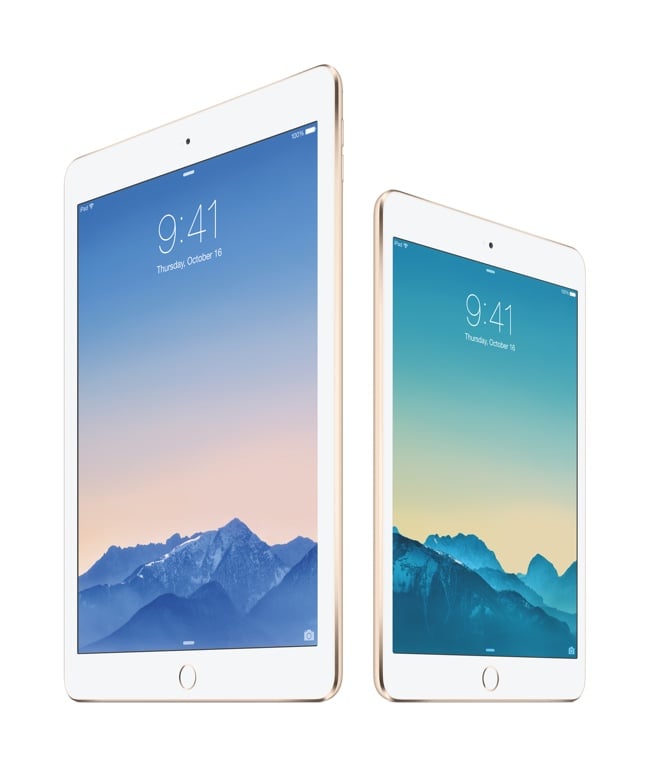
Instead, Tim Cook’s 2014 iPad reveal kicked off with a CGI laser lopping off a few millimetres from the pencil behind which the original iPad Air had hidden last year. The world’s thinnest tablet is the key sales pitch, Phil Schiller defining it as 6.1mm, 18% thinner than last year’s iPad Air. Moreover, the screen is now laminated, eliminating the air gap, for an even sharper, more vibrant display and an anti-reflective coating reduces reflections by 56%.
While the iPad Air basically used a slightly higher clock speed version of the same chip in that year’s iPhone, the Air 2 has its own specific chip - the A8X with three billion transistors compared to 1 billion in the A7. The CPU is 40% faster this year, while the GPU delivers 2.5x faster graphics. The latter in particular made for a great chart showing 180x improvement over the original iPad, although to what purpose we wait to see.
Surprisingly, Schiller identified the camera as the iPad’s most loved feature. Forget all the times you’ve mocked tourists shooting photos with their iPads, Schiller insisted it was no surprise people loved their iPad's camera - its sheer size provided the best viewfinder ever and of course it made reviewing, editing and sharing pictures so easy.
Consequently, the 2014 iPad introduces burst mode photography, time lapse, up to 43 megapixel panoramas, slow-mo videos (720P at 120fps) and there’s also now two microphones to capture audio. Most of these improvements come via the A8X processor, but the camera itself is improved - an 8 megapixel sensor with a faster f/2.4 aperture. The front facing camera is also improved for even better selfies. Admittedly, the pictures and videos (including George Clooney’s wedding procession in Venice) were very impressive, but the lack of the iPhone 6 Plus’ Optical Image Stabilisation meant that while the gap between iPad and iPhone might be narrowing it’s still there.
The iPad software demonstration continued the imaging theme. First up were the guys behind Pixelmator, the award-winning Mac-only PhotoShop competitor which is now making the jump to iOS. The demo showed a desert scene with an impressive image repair feature used to remove a stray animal and clean up the shot before a text overlay. A circular, touch-friendly interface apart, Pixelmator didn’t do anything dramatically new or indicate how it might rival the desktop version. Price at around $5, it’s due in App Store soon.
Next up were some ‘genius French scientists’ whose Replay video editing app uses smart AI to automatically apply visual effects to jazz up your home videos. A real-time volumetric light rendering sequence was admittedly impressive, but Apple’s own iMovie is a pretty good video editor in its own right and Reply wasn’t dramatically pushing the iPad into new territory. The A8X apparently delivers 4x faster rendering than the A7 however, with Metal offering a 20x improvement compared to running on CPU alone. While already available on the App Store now, the enhanced version ships at the end of the month.
Ultimately, the most surprising aspect of the iPad announcement came at the end, with the admission that while the iPad Air 2 benefits from the A8X and M8 motion co-processor, the iPad mini 3 stays with last year’s A7/M7 chipset - the only distinguishing feature is that the mini 3 has Touch ID while the 2 doesn’t. Moreover, not only will last year’s iPad mini 2 be kept in the line-up, so will the original non-retina iPad mini. The latter model provides Apple with its cheapest ever iPad, just £199.
For Apple, the aggressive pricing comes with its own costs as the original iPad mini is essentially a slimmed down iPad 2 with the A5 chip from 2011. Consequently, developers will not be dropping iPad 2 compatibility for a while yet.
The iPad Air 2 starts as before at £399 for a 16GB Wi-Fi model, but 64GB (£479) and 128GB (£559) offers more storage space than before. A welcome change, but the low-end is where storage is tightest and leaving than unchanged was disappointing. The 16GB iPad Air is £319, while the 32GB model is £359. Pre-orders for the iPad Air 2 begin on Friday with shipping starting on the 17th.
The iPad mini 3 starts at £319 for 16GB rising to £479 for 128GB. The iPad mini 2 is £239 for 16Gb and £279 for 32GB. As usual, cellular capability is a £100 extra for all models.
Mac mini reborn
In all the speculation about the event’s ‘it’s been way too long’ tagline, the Mac mini seemed the most unlikely punchline. The Mac mini was last updated two years ago and for some while the speculation has focused more on its discontinuation than any new features. Steve Jobs loved to talk about the Mac being the computer for ‘the rest of us’, but that statement too often leant on the Mac’s usability rather its pricing. But alongside the £199 iPad mini, we now get the £399 Mac mini (£100 cheaper than the previous model) with a 1.4GHz dual-core Intel Core i5, 4GB RAM, 500GB hard drive and Intel HD Graphics 5000. At £569, you get a 2.6GHz i5 with 8GB RAM, 1TB hard drive and Intel Iris Graphics while the top-end 2.8GHz model has a 1TB Fusion Drive for £799.
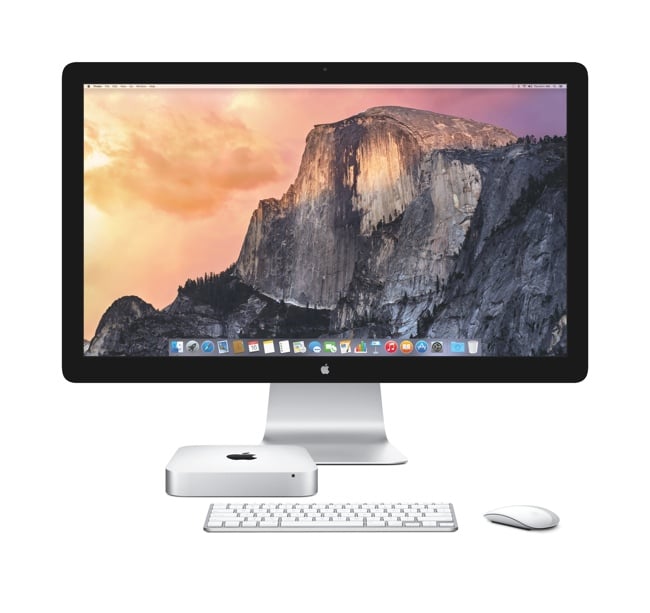
The Mac mini didn’t get much on stage time, but after a two-year gap, it’s good to see the model being refreshed and repriced as part of what seems a broader Apple strategy to widen its market share. Tim Cook praised it being for the most energy efficient desktop in the world, but its competitors will likely fear the price cut most.
OS upgrades & iWork
As expected, OS X Yosemite became available for free download shortly after the event closed. Compared to previous years, there was perhaps less buzz around the OS reveal due to an extensive public beta. This has undoubtedly helped defuse the fears of Mac owners that adopting the look and feel of iOS 8 would in any way dumb down the OS. Moreover, Yosemite is a more graduated design overhaul than iOS8 - in some ways for the worse with Mail and Contacts app icons looking halfway between skeumorphism and the new flatter look.
The principal visual impact in Yosemite is the embrace of transparency, the minimisation of chrome to make content absolutely dominant. When scrolling through a website with bold colours, seeing an image run underneath the translucent browser buttons is a pleasing effect.
In terms of features, Apple’s Craig Federighi, Senior VP of Software, essentially reran a truncated version of the WWDC14 Yosemite preview - once again focusing above all on the ease with which someone can now move between iPhone, iPad and Mac. Subtle icons on all three devices enable you to carry on writing a Pages document or browsing the same webpage as on another device. You can pick-up a phone call on your Mac, read an SMS. Yosemite supports the same Macs as Mavericks and overall feels solid in daily use, but the Continuity features and use of Apple’s new iCloud Drive are still evolving. Any workflow relying upon iCloud Drive should be tested personally before you rely upon it.
For iOS, an 8.1 update will be available for free download on Monday 20th, adding support for Apple Pay, iCloud Photo Library, restoring the Camera Roll feature and improving Continuity features with Yosemite.
iWork had a blink and you missed it appearance, with updates today for Mac and iOS to support Yosemite’s iCloud Drive, better sharing of iWork files by Dropbox etc, and a refreshed look for the Mac version to fit with Yosemite. When Microsoft was enemy no.1, iWork has commanded significant stage time. This time, with a touch friendly Office 365 suite selling nicely on the App Store it barely registered. In fact, the entire Apple Mac range has Yosemite updates now, even the soon to be discontinued Aperture.
That’s all for 2014…
Tim Cook wrapped up with an Apple-centric vision extending from the Apple Watch to the iMac, with seamless interaction between different devices as Yosemite/iOS 8 mostly realises right now. Due to the sheer physics of the Apple Watch’s size, its advantages will rely upon how well it integrates with the rest of Apple eco-system.
To what extent Intel’s failure to ship Broadwell chips affected Apple’s 2014 line-up is impossible to tell, but it seems likely Eddy Cue’s ‘best ever’ Apple line-up might not fully materialise until 2015 with MacBook Air Retina. The success of the super-size iPhone and 3x assets in iOS 8 also indicate the 12-inch iPad Pro may yet appear, but for 2014 Apple’s headline line-up is fixed - although we hope the Mac Pro may yet get a spec update for Xmas…
By K. Stewart
Tags: Technology


Comments